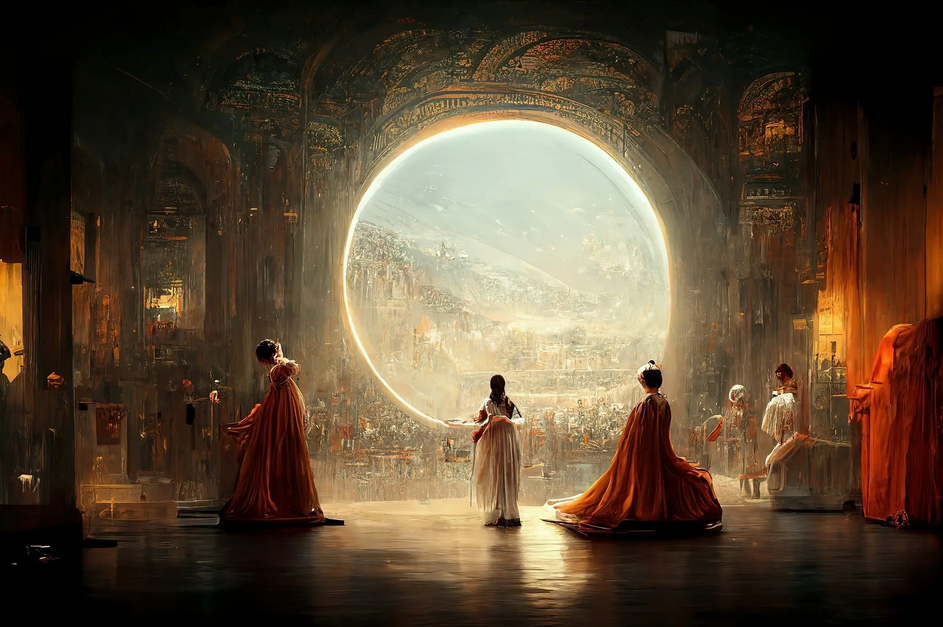Art and AI
[13 Sep 2022]Artworks involving some element of ‘technology’ (essentially some form of artificial intelligence [AI]) are attracting more and more attention in biennials, museums, galleries, art fairs, but also at auctions. This attention ranges from excited enthusiasm for the new possibilities of AI… to bitter controversy.
In late August, Jason Allen, aged 39, won more than just friends after being awarded the top prize for emerging digital artists at the Colorado State Fair, with “Space Opera Theater,” a work billed as his own creation, but created by artificial intelligence. For the artist, AI should be considered as a tool like any other, just like a paintbrush… but it’s detractors do not agree. Concretely, Jason Allen fed the MidJourney AI (an algorithm for generating stylized images resembling paintings) a textual description of the image he wanted to create. The final result turned out to be far from the usual codes of contemporary art, flirting with post-apocalyptic imagery and summoning an aesthetic close to Fantastic fantasy.
“Last August, a work created by AI won a First Prize at the Colorado State Fair.”

Jason Allen with MidJourney AI, Space Opera Theater
The work was very well received by the jury of the Colorado State Fair and by its public as it won the first prize in the category “emerging digital artists”; but this award sparked a wave of fierce reactions on social networks, some accusing the artist of deception… of cheating. Some detractors even announced “the death of art” with the entry of artificial intelligence into the field of creation! However, as this kind of reaction has been seen repeatedly throughout Art History, it is probably fair to say that such exacerbated tensions tend to prove that we are at the dawn of a yet another minor revolution…
On the art market too, AI works are starting to hit the news. A few years ago a work by the OBVIOUS collective (three French artists and a researcher, pioneers in the use of AI as a creative tool) was offered at auction. The group (Pierre Fautrel, Gauthier Vernier and Hugo Caselles-Dupré [the artificial intelligence researcher]), began to be noticed by mixing classic art with the latest technologies, resulting in generative adversarial networks (GANs) on Chinese ancestral portraits thereby giving birth to an entirely new (and artificial) dynasty. This work was considered by some as an example of a new artistic movement: GANism, a movement through which aesthetics is entrusted to the machine, as much, or even more, than to the human eye.
A look back at the beginnings of AI in art auctions
In 2018 the collective was contacted by Richard Loyd, a specialist at Christie’s Prints & Multiples Department in New York, who was interesting in seeing how the market would react to the first ever AI artwork to be offered in an auction sale. A work entitled Edmond de Belamy, a digital print on canvas of a portrait with blurred contours, presented in a gilded frame, was selected. At first glance, the portrait looks deliberately classic. However it was in fact created by an extremely ‘over-educated’ software program that had analyzed and incorporated 15,000 portraits painted between the 14th and 20th centuries. In short, it was a very expensive working process, which required enormous computing power. The program had apparently learned to “understand the rules of the portrait” before independently generating a series of new images, thanks to the algorithm developed in 2014 by Ian Goodfellow, researcher at Google. The members of Obvious chose eleven images resulting from the work of the machine, each having been attributed to different characters of a fictional family called “Belamy” (a translation into French of “Goodfellow”, the researcher’s surname).

Obvious, Edmond de Belamy
“We have found that portraits provide the best way to illustrate our point, namely that algorithms are able to emulate creativity.” Hugo Caselles-Dupré, from Obvious
When the Edmond de Belamy work went on sale at Christie’s in October 2018, it was estimated between $7,000 and $10,000. Nobody really knew what to expect; but enthusiasm for ‘new technology’ tools and the ‘first AI work’ offered at auction (by one of the world’s largest auction houses) propelled the work to a spectacular price: $432,500, forty-three times its high estimate!
But Obvious did not maintain this price level at auction: the maximum price recorded since then has been $25,000 for La Baronne de Belamy (2018), from the same series (Sotheby’s New York; 15/11/2019 ). Only time will tell if the craze picks up again… if the market will decide once again to support Obvious‘s prices… to salute their pioneering work in the field of artificial intelligence applied to art.
In 2022 an AI work has once again distinguished itself on the auction market in the form of a creation by ‘Sophia’, the first robot-humanoid on the art market. Her result (i.e. the price paid for ‘her’ creation) can be discovered in Artprice’s Ultra-Contemporary Art Market Report focused entirely on works by under-40 artists and scheduled for online publication on 4 October!




 30.6
30.6
